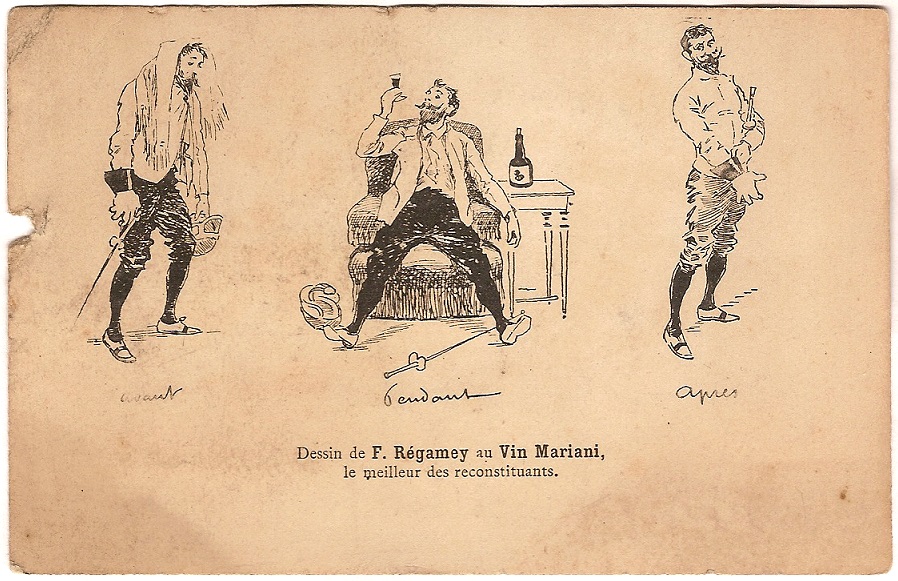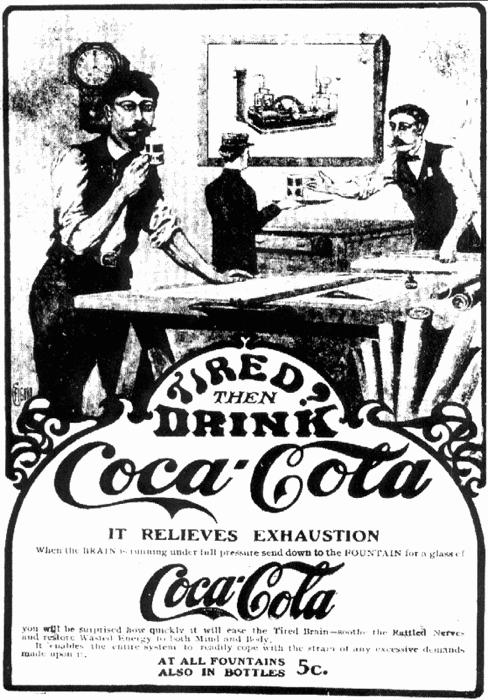 |
| via |
Via one of my favorite websites, MessyNessyChic:
 |
| Click to embiggen |
Most of us have heard the story about how Coco-Cola once contained a significant dose of cocaine (and 7-Up contained lithium) until it was removed from the recipe in 1903. Less well-known is the story about how Coca Cola originates from an alcoholic drink based on cocaine and wine, Bordeaux wine to be specific - a particular combination which made for a distinctly more toxic beverage, known as Coca Wine.
Coca Wine was first developed in 1863 by a French-Corsican entrepreneur in Paris, Angelo Mariani. His advertising in Europe and the United States claimed the tonic would “cure melancholia … restore health, strength, energy, and vitality”. During the second half of the 19th century, everyone was drinking the stuff. Vin Mariani was a favorite amongst celebrities of the day including Thomas Edison, Jules Verne, Sarah Bernhardt, Ulysses S Grant and was even Queen Victoria’s drink of choice. Pope Leo XIII personally endorsed the wine, lending his face to the brand’s advertising campaign - he even awarded it the Vatican gold medal.
And, in fact, when alcohol and cocaine combine, they form a chemical they create a third unique drug called cocaethylene, which produces a feeling of euphoria more powerful and longer lasting than cocaine is capable of producing on its own.
There were copycats, of course. In the 1880s Dr. John Pemberton, a pharmacist in Georgia who was himself a morphine addict following an injury in the Civil War, set out to make his own version. He called it Pemberton's French Wine Coca and marketed it as a panacea. Among many fantastic claims, he called it "a most wonderful invigorator of sexual organs".
When his home state passed Prohibition legislation in 1886 (many states passed their own versions prior to the 18th amendment in 1920), Pemberton scrambled to come up with a non-alcoholic version replacing the wine with a syrup and naming it Coca Cola. Cocaine remained the principle active ingredient of the new carbonated drink for nearly another two decades, although Pemberton added ingredients that Vin Mariani lacked, such as damiana (wiki), a reputed cure for impotence, as well as kola nut, a source of caffeine - both were later included in Coca-Cola.
When Pemberton’s health began to fail in the late 1880’s, he sold his little company and the formula for Coke to the far more successful Atlanta druggist, Asa Candler, in 1888 for $2,300. Pemberton died later that year at age 57. Candler’s success didn’t go unnoticed - North Carolina businessman Caleb Bradham launched a copycat product in 1893, without the coca leaf extract. He called it Brad’s Drink. Five years later, looking for a name to convey its fizzy appeal, he rebranded it as Pepsi-Cola.
The Atlantic had a not-particularly well-sourced article a few years ago claiming that Coca Cola removed the cocaine because African Americans could get bottles of it:
During that time, racially oriented arguments about rape and other violence, and social effects more so than physical health concerns, came to shape the discussion. The same hypersexuality that was touted as a selling point during the short-lived glory days of Vin Mariani was now a crux of cocaine's bigoted indictment.
There was at that time a growing fear of drug abuse which made coca-based drinks less popular, and Pemberton’s successors preemptively took the cocaine out of his drink (at least most of it) in 1903. Eleven years later, in 1914, the drug was officially banned, forcing Vin Mariani and other Coca Wine brands out of business and off the menu forever.
Per The Atlantic:
The Coca-Cola we know today still contains coca -- but the ecgonine alkaloid is removed from it. Perfecting that extraction took until 1929, so before that there were still trace amounts of coca's psychoactive elements in Coca-Cola. As Dominic Streatfield describes in Cocaine: An Unauthorized Biography, the extraction is now done at a New Jersey chemical processing facility by a company called Stepan. In 2003, Stepan imported 175,000 kilograms of coca for Coca-Cola. That's enough to make more than $200 million worth of cocaine. They refer to the coca leaf extract simply as "Merchandise No. 5."The facility is guarded.
Further reading:
The very first Coke? It was Bordeaux mixed with cocaine... and 23 other interesting facts about the world's best-known brand.


No comments:
Post a Comment